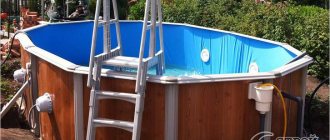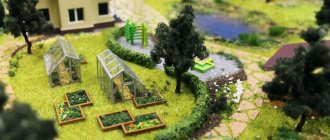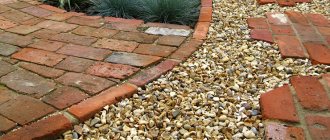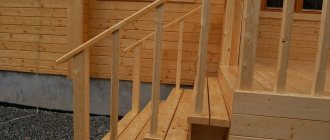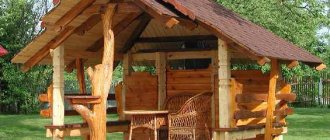Basic rules for leveling a site
An area that has a flat surface is ideal for laying out lawns, gardens, planting flowering plants, and creating a vegetable garden area.
On the site you may encounter various problems, for example, a densely trampled road, debris, large stumps, stones or swampy soil. If the area is small, you can level it yourself, but if the area is large, then you need to resort to the help of special equipment. The planting area does not need to be perfectly leveled; an angle of inclination of up to three degrees to the south is allowed so that all plants can be illuminated by the sun.
During such work, the soil is removed, moved to a low-lying place or added to the ground. To get a well-groomed, level and beautiful area, you need to complete all the work to level it.
- First, the area must be cleared of debris, large stones and weeds.
- If there are old and dilapidated buildings, they must be dismantled.
- After this, a site design is completed on paper.
- Then level the area and plant a garden, lawn or vegetable garden.
Basic methods of leveling land
There are several most common options for leveling a summer cottage, which can be used in the future to solve most problems. These include:
- cultivation
- layout
- bedding
Each of these methods has its own nuances, so it would be useful to dwell on them in more detail.
What do you need to know when preparing a site?
When leveling the soil on the site, it must be taken into account that the angle of inclination can be no more than three degrees, the slope should be directed towards the south. If the slope is very steep, then you will need a large amount of soil to be added or you need to build terraces with retaining walls so that the soil does not slide down. In such a difficult situation, it is first necessary to draw up a project and carry out work on it.
When leveling a site, you need to know the composition of the soil and the features of its location. If there is constant stagnation of moisture in the area, then it is necessary to consider creating a drainage system. You can place a special container at the lowest point of the site, it will serve as a water collector, or you can place crushed stone under the fertile layer, which serves as a drainage material. You can also make drainage using drainage pipes.
Preparation
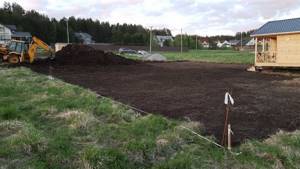
The greatest effort to level the site at the dacha must be made before the start of construction. What you need to start leveling work:
- Determine the side and upper angle of inclination of the site. It is advisable to contact land surveyors who will professionally assess the soil, determine the location of the upper groundwater, and give advice on what angle needs to be raised in order to level the garden;
- Clear the area up to the road, removing debris and beds from the ground, uprooting plant roots;
- Divide the ground up to the road into exactly 9 parts, mark the boundaries with pegs with ropes tied exactly level.
If the site does not have an upper corner and a slope in one direction, but consists of holes and hills, then everything can be leveled with hand tools. A rope on pegs will help you level the terrain with your own hands at no additional cost. But, if the terrain of the area is too uneven, then you can use one of the following tips.
How to seek the help of specialists?
If it is impossible to do the work yourself, then you need to seek the help of specialists. The price of such work can vary, depending on the complexity of the work and the season. Also, the cost of work depends on the use of special heavy equipment, such as a tractor or bulldozer.
There are special companies that deal with land leveling; first you need to visit them and find out the prices for the upcoming work. In summer, the cost of such work will be lower than in winter, since in the warm season the density of the earth is low and digging is easier.
If the cost is affordable, then you need to call a specialist to the site to get advice and create a project. Additional land will have to be purchased independently, and rental of special equipment is paid hourly.
Therefore, before resorting to the help of a special company, it is worth considering that if the area is small in size, then you can save money and carry out the leveling yourself. You can hire equipment if the slope is too steep and the area is large.
How to level the area yourself?
If the ground is slightly uneven, you can simply dig up the top layer, remove the weed roots, and level it evenly over the entire surface. To do this, you need to install stakes and pull the rope at the same level where the earth should be distributed. You can not use a rope, but dig the stakes at the same level, and use a level to check that their tops are located at the same height.
If the ground is significantly uneven, first remove the turf using a shovel and rake; it can be replaced with ordinary black soil. Then they begin to level the land, removing it from elevated areas to depressions, after which the turf is returned back or replaced with fertile soil. After 20 days, the soil will have completely settled, and you can begin planting plants for the lawn, garden or vegetable garden.
If water stagnation is observed in the area, then it is necessary to make a drainage system; for this, the fertile soil is removed to the side and 10 centimeters of gravel or crushed stone are filled in; broken bricks can be used. You can also dig a trench at the very bottom of the site, place sand and gravel in it, such a device will serve as a water collector.
You can use another method of drainage, this is laying pipes that are located below the fertile ground level. To lay them, special trenches are made, the bottom is compacted, filled with crushed stone and sand, and then they begin laying pipes that have special filters in the form of a mesh.
Additional work related to site leveling
- Before leveling the area, you should carefully assess the quality and condition of the land. Then, in the process of work, you can correct some of its shortcomings, for example, make heavy soil lighter, increase the cohesion of sandy soil. Thus, peat soil will serve as a good fertilizer and will help increase the air permeability and water permeability of the soil. And peat-sand will improve its drainage properties.
- At this time, it is also worth taking care of drainage. This can be either simple drainage, consisting of various water-permeable layers (broken brick, fine gravel, coarse sand, etc.), or a complex system using plastic drainage pipes. In parallel with the drainage, an irrigation system can also be installed.
- Not every site has a large enough fertile soil layer. Beneath it there is the so-called subsoil layer, which is very poor in composition and is not suitable for growing plants, so it should not be placed on the surface.
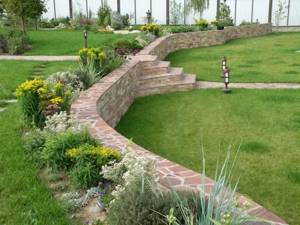
But at first, the turf layer will produce active growth of weeds, and its thickness is small. In any case, black soil should be brought in. By mixing it with turf soil, you can increase the volume of the fertile layer, or even better, completely replace it. A complete replacement will be more expensive, but when you plant the plants, you will be pleased with the result. It is very difficult to level an area with a slope, but it is possible to cope with this if desired, even on your own. Or you can show your imagination and use the unevenness of the site to decorate a chalet-style dacha and enjoy the result. The choice is yours.
How to level a plot into squares?
To measure evenness, use a building-type level or a tube with a hose. First, excess soil is removed at higher elevations, the soil is left below, and sand is poured on top, and then the soil is returned back.
After removing the top soil, determine the point at which the ground is leveled and drive a stake about 10 centimeters higher. From this stake, the entire area is divided into squares, with additional stakes installed at each corner. All stakes must match in height, based on the very first installed element. When all the stakes are installed, you can determine at what level and square the soil should be added. To level and perform the work, you will need rakes and shovels. Leveling the area into squares will help create a perfectly flat surface, without bumps or depressions. In this way, you can level out an area that has several significant depressions and bumps.
Leveling the ground with terraces
Leveling a site located on a steep slope can be done using special structures called terraces. To carry out the work, you need to prepare a spirit level, stakes and level. First, horizontal slope lines are placed; the stakes should be placed at a distance of up to 2 meters from each other. After this, the vertical lines are calculated; they will depend on the steep slope and its shape. Then the bevel of the steps and their horizon are determined; if the elements have a large height, then it is necessary to install supporting walls. This must be done to prevent the earth from sliding down the slope during heavy rains in the autumn.
If there are beds located on the steps, then the fertile soil is removed and laid back when the entire structure is completed. The area for the beds is also provided with supporting walls so that the earth does not move down due to significant weight.
It is better to plow clay-type soil in the autumn, and repeat the work in the spring, then you need to use a cultivator, then remove the roots of the weeds, and begin to level the soil with a board.
How to put a fence on an uneven area
On an uneven area with a slope, the fence can be placed with the same slope along the upper level or stepped. If corrugated sheets are used for fencing, then in the second case the work is easier to carry out and, in addition, such material is better suited for sloping areas.
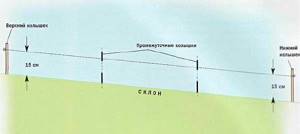
Marking the area for construction
Preparatory stage of fence installation
Before building a fence on a slope, you need to carefully prepare so that in the future you get a beautiful and reliable fence that is not afraid of precipitation or strong winds. Preparation includes:
- marking uneven territory;
- planning and calculation of a fence on a slope;
- purchase of building materials.
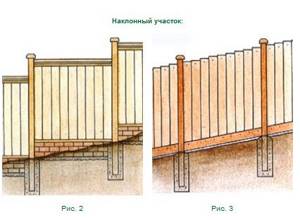
Sketch of base options
To determine the consumption of building materials for a fence on an uneven area or slope, measure the perimeter of the area. To determine the consumption of corrugated sheets for building a fence, you must remember that the fastening of the sheets is done with an overlap of 8–12 cm.
How to level the ground, creating the necessary slope?
If you need to level the area so that a slight slope remains, then you need to perform certain actions.
- First you need to decide on the level of slope of the site.
- Place a stake at the lowest point of the site, and align all other stakes at the required angle.
- After this, a rope or fishing line is pulled between the stakes, and leveling is carried out along it.
If you have a cultivator, it is easier to care for the area, even if it has a slight slope. But after carrying out such work, it is imperative to remove the roots of the weed, otherwise it will interfere with leveling and the full growth of plants.
Even a significant slope can be leveled out yourself or, on the contrary, you can make a small slope so that the site has an original appearance.
Fence on a site with a slope: options
Before making a fence on a slope, you need to evaluate your own strengths and the tasks of the fence, determine the drop and slope of the surface. If this is protection from destruction, then it is advisable to build it from stone or brick on a strip foundation. If you install a fence on an uneven area for decorative purposes, then you can choose wood, corrugated sheet or picket fence as a building material.
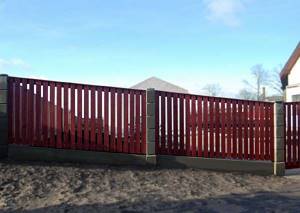
Sloping fence at the dacha
The type of terrain slope may vary. In this regard, it is worth noting the following:
- A low slope will allow you to build a fence that follows the correct curves of the landscape. In this case, the fence fabric can be level. The foundation for the fence is either completely absent, or a strip foundation is used.
- On a steep slope, these fencing construction options look unattractive. At the same time, the need for strengthening will require a thorough construction of the foundation. The fence can be made level by installing a leveling or stepped base. That is, the individual elements are in the form of steps and have different levels.

Wooden picket fence on uneven ground
If there is no need to strengthen the soil on the slope and the construction of a reliable foundation is not in the construction plans, then you can build a fence from Euro picket fence, boards, chain-link mesh, or corrugated sheets. You can build a fence with steps, mounted on poles, gradually rising.
The downside of this fence is that large voids appear at the bottom in the form of a triangle. They give open access to various animals. Intruders can also get in.
One way to correct this problem is to plant evergreen perennials or use flowerpots to plant shrubs.
Thus, the fence protection function can be combined with a decorative one. You can get rid of voids under a wooden fence by cutting out the lower part in the shape of a triangle.
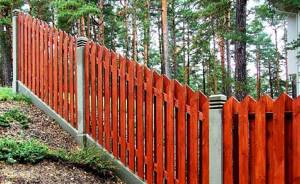
Fencing a private house
If you install a fence on a slope, the choice of building material will also depend on the personal capabilities of the home owner:
- A fence made of wood or corrugated board is the most suitable way to build it yourself.
- Fencing made of beams or picket fences can be used for a fence that follows the slight elevation of the site.
- The most durable, but also the most expensive, is a concrete, brick and stone inclined fence. The construction of such fences will require a lot of preparation, experience, and a significant investment of time and money.
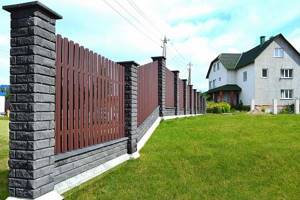
Metal picket fence with stone pillars
What tools and equipment will be needed to level the ground?
In order to level the area yourself, you need to prepare the following materials:
- Use a shovel, fork and rake to move the fertile soil aside and level the bottom layer.
- Thick wooden boards for final leveling of the surface and its compaction.
- A container that is filled with water is necessary when compacting the earth.
- A wheelbarrow is used to transport earth to the desired site.
Some tools can be replaced with other, more convenient ones, the main thing is that the work is carried out in a convenient way.
If the site is of significant size, then they resort to the use of special equipment:
Using a tractor, you can move soil from unnecessary places to necessary areas.
A bulldozer will help remove fertile soil; you can also use a grader for these purposes.
After the main work is completed, the land is plowed using a cultivator.
If equipment is not needed, all work can be done manually, but this will take a lot of time and effort.
Results
- You can level the area yourself, without the use of special equipment, but first you need to prepare all the necessary tools, and if possible, then resort to the help of friends and relatives. This will help save time and effort.
- The leveling method depends on the structure of the soil, its slope and composition. It must be remembered that before starting work, the entire fertile layer of soil is removed to the side and then returned. This allows plants to develop in a favorable environment. Before seeding your lawn, you may want to seek advice from a plant specialist.
- If the plot size is significant, you can use the services of machinery, that is, a tractor or bulldozer. With its help, all work will go faster and better. Rental of such equipment is paid by the hour.
- When leveling the site, an angle of inclination of no more than three degrees towards the south is allowed, so that all plants can be well illuminated by the rays of the sun, and moisture will not be retained on such soil.
An ideally flat area will have a beautiful appearance, and the plants located on it will receive the necessary amount of light and heat for full development. Self-leveling of the ground surface can be done with a small plot size. But if it is large enough, and it is impossible to do all the work manually, then you need to rent equipment, for this you need to contact a special company that deals with leveling the land. After finishing the work, you can place a lawn on the site, plant garden or garden plants, and also carry out construction.


